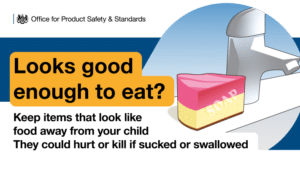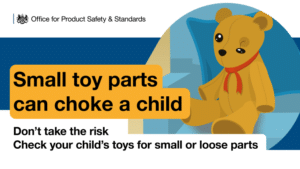25th April 2022
In support of the Office for Product Safety and Standards (OPSS) #NilByMouth campaign, we are delighted to share the third in a series of Voices blogs by Lizzie Tinsley, Senior Sister & Practice Development Nurse, Children’s Emergency Department, The Hillingdon Hospital. This Voices blog focuses on small toys.

Lizzie Tinsley, Senior Sister & Practice Development Nurse, Children’s Emergency Department, The Hillingdon Hospital
As part of this special series of blogs to raise awareness of the importance of health visiting in reducing accidents, today’s blog focuses on the risks posed by small toys. I have already spoken of the serious risks posed by button batteries and magnets to children’s digestive systems, however there are hundreds of other items in homes and outside that can cause a child to choke. Being aware of these items and the risks that they pose to children is important – this will help everyone working in health visiting teams have meaningful discussions with families about ways to reduce these risks and prevent avoidable harm.
In both my time as a health visitor and a children’s emergency department nurse, I have found that younger siblings rather than first-borns seem to have more choking incidents. This is likely due to both the lack of understanding of the first-born children of the choking hazards posed by their small toys to their young sibling, but also parents seem to relax more with the second child and are possibly less cautious if their first child had not had any choking incidents.
The most common items I see having been swallowed in the emergency department are coins, either due to a child being given them to play with or having been found down the side of a sofa or dropped on the floor. We frequently see Lego being swallowed, often attributed to belonging to an older sibling. The Royal Society for the Prevention of Accidents (RoSPA) (2022a) also references the risks of broken toys, which parents should be encouraged to dispose of quickly to ensure that small pieces, which could be sharp, don’t get swallowed. They also highlight the risk of nappy sacks being left within reach of a baby (RoSPA, 2022a).
We will all have been involved in supporting families following accidents, and certain stories will stick with me forever. A few years ago, I had a 4-month-old attend the emergency department following a respiratory arrest. The mother had heard a noise on the baby monitor and, when she went to check, had found a nappy sack in the baby’s mouth and throat, which she pulled out and had to stimulate baby to start her breathing again. This was a ‘near miss’ that could have proved fatal. Many new parents find keeping nappies and changing items close at hand for nighttime changes convenient, but health visitors need to highlight the risk of keeping such items within the baby’s cot or reach.
In the last few weeks, we have had two infants attend the emergency department in a serious condition following choking. One choked on an apple and the other a balloon. Sadly, one of the babies has now passed away. RoSPA (2022b) report that, on average, a child dies every month in the UK from choking, and hundreds attend hospital for treatment.


Most accidents are preventable through increased awareness. However, with so many hazards in the home, and many sold as items for children, parents can be overwhelmed at the prospect of keeping their child safe. In many cases of choking and ingestion of hazardous items, children are not in their own home or are not being looked after by their parents. Health visitors can raise awareness with parents about ensuring other caregivers are also aware of the risks to the child. Babies and small children are most at risk from choking because they examine things around them by putting them in their mouths. Helping parents understand their child’s developmental stage and suggesting that the parent provides suitable toys if someone else is caring for their child can help to highlight the need to ensure children and infants are only exposed to appropriate and safe items of play and food.
Share ‘top tips’ to avoid choking:
- Keep small objects out of reach
- Watch out for small, round food items – including chocolate eggs with small toys inside
- Never let children run with objects, including food, in their mouths
- Choose safe toys, appropriate for the age of the child.
Health visitors should also educate parents on safe toy regulations and which safety marks should be present, such as Kitemark, CE, UKCA and BTHA Lion Marks. Parents should also be made aware that although toys that don’t meet UK safety requirements are illegal, they can still be found, so they should take care (RoSPA, 2022c).
Most toys with small parts will also have a choking hazard or age restriction on the packaging, and parents should be encouraged to take heed of this, paying special attention to ensure older children are keeping their toys away from younger siblings.
Lizzie Tinsley, Senior Sister & Practice Development Nurse, Children’s Emergency Department, The Hillingdon Hospital
References:
- RoSPA (2022a) https://www.rospa.com/media/documents/home-safety/choking-leaflet-northern-ireland.pdf [Accessed 21/04/2022]
- RoSPA (2022b) https://www.rospa.com/resources/hubs/keeping-kids-safe-(1)/choking [Accessed 21/04/2022]
- RoSPA (2022c) https://www.rospa.com/home-safety/advice/product/toy-safety [Accessed 21/04/2022]








